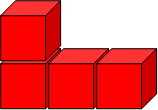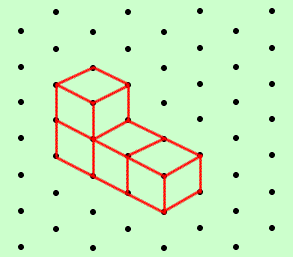Copyright © University of Cambridge. All rights reserved.
'The Third Dimension' printed from https://nrich.maths.org/
Show menu
Why do this problem?
This problem helps learners to relate 3D solids to drawings of them. It requires a systematic approach.
Possible approach
You might like to begin by drawing a shape on isometric dotty paper on your interactive whiteboard which uses, for example, three cubes joined together. Working in pairs, ask children to create the shape for themselves out of interlocking cubes. Ask one child in each pair to draw another shape on isometric paper and for their partner to make it, then swap over. You could repeat this as
necessary, depending on how much experience your class has of drawing in this way.
Introduce the problem itself by making the arrangement of four cubes shown in the picture. Leave pairs to try to make other arrangements for a while without saying much more at this stage, then bring the whole group together to discuss some issues. How are they checking that each shape they make is different from the shape/s they have already made? Has anyone got a good system for making the
shapes so that they are sure they'll be able to find them all? Draw attention to those who have developed a clear approach, for example by having three cubes the same and looking for all the positions that the fourth cube could go etc. Having talked together in this way, children should feel confident enough to find all the different arrangements.
Their models and drawings would make an interesting display, particularly if some pairs were encouraged to describe in words how they went about finding all the possibilities.
Key questions
Is this arrangement different from this one? How do you know?
How will you know when you have found all the different arrangements?
Possible extension
Children could go on to make all the arrangements of five cubes - this is much more challenging and requires a very organised approach. Encourage them to use the four-cube arrangements as a basis for this extension.
Possible support
If some learners are struggling with drawing the models, provide enough cubes for them to be able to keep each one as they make it.
Some pupils might find it easier to try Building Blocks before starting this activity.
Some pupils might find it easier to try Building Blocks before starting this activity.

